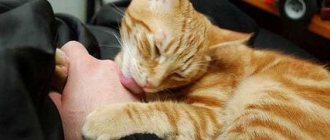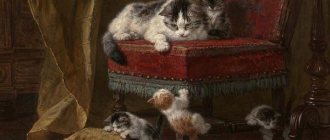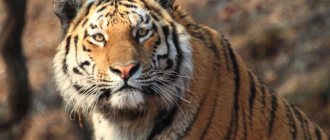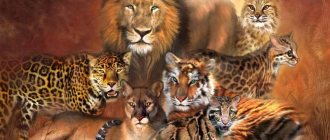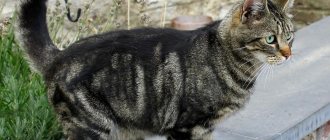Tiger – striped perfection
This is the largest wild cat in the world. In size, the tiger is second only to the bear. The weight of a tiger can reach 250 kg, height at the withers is up to 1.15 cm. The body length of an adult predator is more than 3 meters. The largest tiger was killed in the middle of the last century in India, its weight was 388 kg. Currently, only six subspecies remain, the habitat of which is concentrated in Asia.
A strong, muscular, elongated body, a more developed front part, a round head with a convex skull and a bright striped color - this is a brief portrait of a tiger. The most common color is red (of varying intensity) with black stripes, but there are also individuals with white and gold colors. Such unusual colors are associated with genetic disorders.
The tiger is a territorial animal and always hunts alone. The feeding territory of one animal is from 300 to 500 km. Tigers rarely quarrel with each other; if the amount of prey decreases, attacks on livestock and people begin. Possessing excellent night vision, the tiger prefers to hunt in the morning or evening. The tiger prefers to follow the tracks of its prey or wait for it in ambush, for example, near a pond. Unlike the lion, the tiger is very concerned about cleanliness; before going out to hunt, he always bathes or rolls out in the snow to fight off the smell that could scare off the prey.
A tiger can attack people if the boundaries of its territory are violated or if the food supply decreases. People are easy prey for this predator.
Now, due to a decrease in the population, such cases occur extremely rarely, and when a tiger encounters a person, he prefers to retreat. But before, attacks by man-eating tigers were recorded more than once. The Bengal tigress is widely known and has killed more than 400 people. It was suggested that a tiger, having tasted human flesh, would continue to prefer this type of prey.
All tiger subspecies are classified as endangered and are listed in the Red Book. Tiger hunting territories are protected by the state. A breed of cat was developed that resembles a miniature tiger, called the Toyger.
Reproduction and lifespan
Females of large cats are ready to mate when they reach 1.5-3 years, males - a little later. There is no mating season; estrus continues until pregnancy occurs. Males prefer to live separately from females (with the exception of lions). The female independently takes care of the offspring, feeds and trains the babies. How long does he live? Representatives of the genus Panthera live from 12 to 25 years in natural conditions, and much longer in captivity.
Photo of a leopard and a black panther
Amur (Siberian) tiger
In the photo: the largest wild cat in the world is the Amur tiger.
A serious and beautiful predator, with thicker and longer fur compared to other subspecies. The only one of the tigers that has a layer of fat on its belly to protect it from the cold. The largest population of these animals lives in the Khabarovsk and Primorsky territories; it numbers about 500 individuals. In neighboring countries, the number of this tiger is very small due to its valuable fur and ingredients valued in eastern alternative medicine.
Even in the last century, the number of Amur tigers was so great that special teams were sent to hunt them. And in less than 50 years, the number of this predator has decreased to 200 individuals. Now, thanks to the efforts of biologists, the population number has increased.
However, at the moment the Amur beauty is under threat of extinction.
Lion is the king of the animals
A dangerous predator who is not alien to nobility and greatness. The weight of a lion can reach 250 kg, and the height at the withers is about 123 cm. The length of the body ranges from 170 to 250 cm. In its structure, a lion is very similar to a tiger. Color varies from dark brown to sand. Lions are the only ones from the family of big wild cats to have a small tassel at the tip of their tail. Females differ from males not only in their smaller size, but also in the absence of a mane, the main decoration of a lion. It is not for nothing that he is called the gentleman of the world of predators. His proud, majestic demeanor and noble warning of the start of the hunt with a royal roar make one admire and admire this animal from afar.
They are the only ones from the family of big wild cats that do not live alone, but in peculiar families - prides. Typically, a pride includes females, cubs up to three years old and several males. The pride is led by a leader, an experienced and strong male. During the hunt, females usually serve as beaters, while males wait in ambush. It is almost impossible for an outside lion to get into the pride; an exception is made only in the case of a female vacancy. As a rule, the number of prides is the same and is regulated, obviously, depending on the food supply.
The lion's extant range is in Africa, with a small population in India.
Photo gallery: wild African black-footed cat
A black-footed cat can catch a bird when it flies low above him.
Blackfoot hiding in the bush
Black-footed cats retain their wild nature in captivity
The black-footed cat mercilessly expels strangers from its territory
At the slightest danger, the kittens hide and wait for their mother. In the summer, the black-footed cat has a very bright and contrasting color
The black-footed cat sleeps curled up in a ball, like most representatives of the cat tribe
The dry desert regions of Africa are the natural habitat of black-footed cats.
The black-footed African wild cat looks unusually sweet, but in this case, appearances are extremely deceptive. The little animal is a desperate and brave hunter who needs to live only in natural habitats, that is where he will be most comfortable.
Leopard (panther) - the most insidious of wild cats of prey
A dangerous and unpredictable predator from the cat family. In terms of jaw power, it is not inferior to its larger counterparts, the tiger and lion, although it is not as impressive in size. The height at the withers of an adult leopard is no more than 80 cm, and its weight is up to 100 kg. The body length is from 120 to 195 cm. The body of this animal is elongated, light, somewhat compressed at the sides. The leopard has very beautiful spotted fur, thanks to which the leopard population has greatly depleted.
It climbs trees well, although it prefers to hunt on the ground. An excellent swimmer, he easily overcomes water obstacles and does not disdain fish. It can sit in ambush for a long time and lie in wait for prey. The natives of the area where leopards live are much more afraid of them than of their larger relatives. They are able to attack from trees too quickly and unexpectedly and misfires rarely occur. Leopards drag their prey up a tree to protect it from other predators. These predators hunt at night and always alone.
The black-colored individuals that appear in litters, called panthers, are considered more aggressive than the normally colored leopard. They received this coloring from the increased content of the hormone melatonin.
Origin of spotted color in cats
The history of this coloring began with the appearance of the first predators. Most experts agree that spotted coat colors were common to many prehistoric cat monsters, including giant jaguars, xenosmilus, smilodon, and mahairod.
Even today, a patterned coat helps predators blend into their environment, making them invisible. Their spotted coat allows them to hide from enemies and sneak up on prey.
For a long time, this coloring was characteristic only of wild representatives of the cat family. But as a result of numerous experiments, specialists managed to obtain purebred animals with spotted fur.
The first domestic kittens of the color called “tabby” were born in America thanks to geneticist Paul Case.
Jaguar - America's largest wild cat
This predatory inhabitant of the jungles of Central and South America is very similar to a leopard, but much more massive and larger. Height at the withers is 63-76 cm, and weight is approximately 90 kg. The body length of a jaguar can reach 185 cm. This representative of the feline is a solitary hunter, both males and females carefully protect their territory from their own kind and from other predators. Only during weddings do jaguars gather in packs; fights between males rarely occur - the female makes the choice. She also raises the kittens until they are old enough to defend their territory.
The jaguar's prey can include caimans, crocodiles, peccaries, snakes, turtles, monkeys and other small and not so small inhabitants of the jungle and reservoirs. This predator does not disdain livestock either. Cases of attacks on people are rare.
In many countries, the jaguar is listed in the Red Book and hunting it is strictly prohibited. In others, such as Mexico, limited shooting is permitted.
Eurasian lynx
Of all the cats that inhabit European forests, the largest is the common lynx. The body weight of a male is about 29 kg, females are 4-6 kg lighter. The body length does not exceed 130 cm. Mammals live in Russia, Central Asia, Central and Northern Europe. At the beginning of the 20th century, the extermination of predators led to the threat of their extinction. Today, lynx fishing is prohibited everywhere.
The animal with tasseled ears and a short tail seems cute and harmless. But under the spotted thick coat hides a skillful and cunning hunter, capable of smelling prey at a distance of 2 km. Its victims include hares, foxes, birds, rodents and small ungulates: roe deer and musk deer. Lynx never attacks people. Even an adult caught by a person is easily tamed and becomes a pet.
Puma (mountain lion)
America's second largest predatory wild cat. The height at the withers is 60-90 cm, the body length is up to 180 cm, and the weight is no more than 100 kg. The body of the puma is elongated, the legs are short, strong, the hind legs are more massive. The head is small. The color of pumas ranges from reddish to gray.
Cougars are found in almost all types of terrain: in the mountains, in forests and on the plains. The cougar is a solitary night hunter and its prey is numerous ungulates; it does not disdain birds, fish and insects. This predator does not distinguish between wild herbivores and livestock and eagerly kills those that come to hand. Moreover, the cougar often kills more animals than it can eat. There are known cases of attacks on people. As a rule, children or short people walking alone are attacked.
Despite the incessant hunting and narrowing of the habitat, the population of pumas is sufficient and large, since this predator easily adapts to other living conditions.
Pumas are found throughout South America, the western regions of North America and the Yucatan.
The rarest breeds of spotted cats
Among the variety of cats with leopard coats, there are those that have not yet become widespread.
These include:
- Australian mist. The breed appeared as a result of crossing Burmese, Siamese and Abyssinians. It has many color options. But spotted cats look the most impressive.
- California radiant. Among the ancestors of these spotted cats are Angoras, Siamese, Manx, British Shorthair and Abyssinians. California shiners have a “wild” appearance. And on their luxurious fur coat there is a tabby pattern.
- Ussuri cat. In all likelihood, this young breed comes from Siberian and Amur cats. The spotted Ussuri visually resembles a predator and has a proud, independent disposition.
- Sokoke or Kenyan forest. This breed originated from kazonzo and partially feral domestic cats. It was approved in 1992 thanks to the efforts of Jenny Slater. Small, flexible, slender, spotted cats are endowed with a wayward, independent character and have a developed hunting instinct.
Spotted cat - Australian mist
Spotted cat - Californian shining
Spotted cat - Sokoke
Spotted cats attract attention with their natural grace and unusual appearance. Despite their “wild” appearance, many of them have a playful, affectionate disposition and high intelligence. It is these qualities that make mini-leopards very popular among those who dream of getting closer to nature.
Irbis - snowy beauty
An unusually beautiful leopard with smoky gray fur with black spots. The snow leopard lives high in the mountains and occasionally descends to the foot, following the migration of ungulate herbivores. In appearance, this strong cat resembles a leopard, but is squat and smaller. The body of the snow leopard is stretched, slightly raised in the sacrum area. The height of the withers is no more than 60 cm, and the body length ranges from 103 to 130 cm. The main habitat of the snow leopard is South and Central Asia.
The snow leopard rarely attacks humans or livestock. This can only happen if the cubs are protected. Snow leopards live in pairs and hunt and raise their young together.
They feed, train and raise their young, and the female mercilessly plucks fur from her belly to insulate her den.
Currently, there are no more than 7 thousand snow leopards worldwide. Unfortunately, snow leopards practically do not reproduce in captivity, so the population of these magnificent animals continues to decline. It is almost impossible to meet this rare endangered species in the wild; the snow leopard carefully avoids people.
Liger
The liger is the largest representative of the cat family. These amazing cats were bred by crossing two different species, so they exist exclusively in zoos. Ligers are distinguished by their unique character traits, which they adopted from both parents.
A liger is a representative of the cat family, namely a hybrid of a male lion and a female tigress. For a long time, scientists did not suspect that these two species could interbreed, although they belong to the same genus of panthers. Also, a lioness and a male tiger can also produce a hybrid - tigon or tiger lion, which is significantly different from its brother. The liger took a confident position as the largest representative of the felines - before that, the Amur tiger took its place.
Evolutionarily, the genus of panthers has many uncertainties, which is why scientists for a long time could not determine which large cats belong to the genus and, moreover, did not suspect that they could interbreed with each other. It is generally accepted that the progenitor of the panther genus is the extinct cat Panther Scowby, which is also the progenitor of pumas. Because of this, pumas were also classified as panthers for a long time. The divergence of cats supposedly occurred about six million years ago, but is still controversial among geneticists. Ligers are unique representatives of the genus. Thanks to their appearance, scientists have resumed research into the DNA of big cats, not excluding the possibility of other interspecies crossings. Researchers believe that snow leopards and jaguars are also prone to interbreeding, but the arguments remain theoretical due to numerous genetic risks. The appearance of the liger prompted zoology to further study big cats.
The liger is a very large animal. It can weigh more than 400 kg, and the standard height at the withers is about 100 cm. Stretching out to its full length, a liger can occupy the entire 4 meters. The width of the mouth of such a predator stretches up to 50 cm. In general, the animal, at first glance, resembles a lion with a sparse mane. The male liger's genes are responsible for development, and the more genes the lion passes on to its offspring, the larger and more massive it will be. The tigress's chromosomes are weaker than those of the lion, which is why the liger's dimensions exceed the standards of big cats. Male ligers have thin or no manes, but their heads are very massive - they are 40 percent larger than the heads of male lions and almost twice as large as the heads of Bengal tigers. In general, the dimensions of a liger are almost twice the size of an adult lion.
The color of ligers is cream and light red. The belly, inside of the paws, neck and lower jaw are white. The coat is thick, soft, with a dense undercoat. Faded brown stripes are located throughout the body. Ligers can be lighter or darker, including white ligers - descendants of a white tigress and a white lion. All ligers have very large paws and a sagging back with a pronounced pelvis.
The belly of ligers is hanging and looks excessively large. Male ligers sometimes have thick reddish sideburns instead of a mane. From the tigress they also got white spots on their ears, which serve a camouflage function.
In the wild, lions and tigers do not have overlapping habitats. Because of this, they do not have offspring - previously, when these two species could have adjacent territories, they also avoided each other due to a fundamentally different way of life: lions are gregarious, and tigers are solitary. However, there are still references to ligers. In 1798, scientists found written monuments that mentioned the offspring of a tigress and a lion, which appeared in animals living in cages in India. In 1837, a liger cub was presented to Queen Victoria as a gesture of goodwill - evidence that tigers and lions had interbred under artificial conditions.
The liger is an artificially bred animal. Lions and tigers get along well with each other in zoos, and this only reinforces interbreeding. Scientists are debating whether ligers can live in the wild. They agree that the most suitable areas for ligers to live are the following territories: India; central USA; South America. Ligers are also often compared to saber-toothed tigers, so it is assumed that in the wild these animals would live in small groups, choosing caves and other enclosed areas. Not long ago, a liger and cubs lived in the Novosibirsk Zoo, but due to genetic diseases, the individuals did not live long.
The liger eats a lot of meat, so the costs of keeping it in zoos are enormous. To maintain the genetic potential of a predator, ligers are regularly introduced to live prey so that the cats can hunt and learn the nuances of wild life. In general, a liger eats from 10 to 15 kg of meat, depending on its gender, age and size. Most often, ligers are served the following “dishes”: chickens, including live ones, which the ligers kill on their own; rabbits, also sometimes live; processed beef meat, offal, heads and hooves with hard bones for ligers to wear down their teeth; eggs, in particular - white, crushed with shell; fat milk.
Ligers do not refuse raw fish and play with it with pleasure. Also, large cats are often offered watermelons: they play with them and, in the end, bite them. Plant food is included in the daily diet of ligers. They are given all kinds of vitamin mixtures to keep the big cats healthy. Such mixtures are especially important for babies, who need to strengthen the skeleton and prevent possible diseases. There is always a lot of fresh growing grass in the liger's enclosure. Big cats often lie among tall grass and bite it - this indicates the need for vitamins in the body of a big cat. They are offered peaches, apricots, tomatoes, cucumbers, lettuce and many other fruits and vegetables as natural vitamins.
The character of ligers can be called versatile. These cats have inherited behavioral traits from both their lion father and tiger mother. From lions, ligers adopted a love for social groups. Lions have a very positive attitude towards all big cats. They easily get along with each other and fit into prides of lions. In relation to other cats, ligers are non-confrontational, love affection, and strive to be close to other relatives.
On the other hand, ligers have adopted from tigers the tendency to mark territory and defend it. The liger has a flock, which he perceives as family, but he also has his own corner, which belongs only to him. Female ligers are especially prone to this, just like tigresses do. Also, from tigers, ligers inherited a love of water and swimming. They willingly frolic in ponds, drag prey there, dive and simply lie in the water - lions have a dislike for water and even fear of bodies of water. The liger is also similar to the tiger in that it can easily withstand low temperatures. Tigers are adapted to cold weather - their fur is known for its dense undercoat, which the tigress passed on to their children - the ligers. At the same time, ligers do not suffer from heat, since their fur provides competent thermoregulation. In severe frosts, ligers happily roll around in the snow, and in hot weather they lie in the water.
Male ligers are absolutely sterile, but females have a chance of having offspring, although it is very low. This does not negate the fact that female ligers have a period of estrus, during which they show increased attention to males of all species: ligers, tigers and lions. A ligress can only have offspring from lions. In search of a partner, a female liger is even able to climb over the high fence that separates her from the enclosure with other large cats. Regardless of whether she ends up with a tiger or a lion, the female’s behavior will be the same.
A ligress in heat marks her territory, letting the males know that she is ready to mate. In zoo conditions, keepers do not allow any exhibition tournaments between male tigers or lions, so the female, as a rule, does not choose a partner for herself - he is simply released into her enclosure. Big cats have very beautiful foreplay. They affectionately rub their heads against each other, lie next to each other for a long time and lick each other's fur. For lions, such foreplay is faster, but for tigers it can last more than a day. After mating, the female and male separate.
Pregnancy lasts about 110 days. As a result, the female gives birth to one or two cubs, and most often these are the same infertile males. The descendants of a lion and a ligress are called liligers, and this is an extremely rare case when the offspring are born alive and healthy. As a rule, cubs do not survive until three months. In theory, female liligers could have offspring with lions, but lions have a strong genetic potential, which is why the resulting offspring will not resemble ligers - they will be ordinary lion cubs. Often, female ligers do not have milk, which is why zookeepers feed their offspring.
Ligers are the largest cats, but they do not live in their natural habitat. In theory, if ligers settled in any territory, they would quickly rise to the top of the food chain, and they would have no natural enemies. Ligers have a number of diseases (in addition to infertility in males) that can cause serious complications for a normal life. Ligers are prone to mental disorders. The fact is that tigers and lions have different sign systems of communication. Because of this, ligers sometimes have problems, as a result of which they cannot understand each other or their relatives. For example, tigers and lions have different warning signal systems, so ligers may see the peaceful calls of other cats as a threat.
This situation can even be observed in the relationship between a ligress and her cubs - she may not understand their sign system, inherited from the lion father, which is why she abandons the children and they are raised by zookeepers. Ligres are prone to depression due to incompatible lifestyles. They are both socially inclined and need privacy. Because of this, ligresses even become depressed. Male ligers do not exhibit this behavior - they love to be the center of attention. Due to their weight, ligers experience enormous pressure on their paws and spine, which can lead to diseases of the bones and joints. It is also impossible to establish the life expectancy of ligers - they live up to 24 years, but scientists are sure that the animals die due to diseases, and not due to natural death.
Ligers live in small numbers only in zoos, where they are monitored by qualified specialists. They do not intend to release ligers into the wild for a number of reasons: they are not adapted to wild living conditions. These cats are accustomed to people, vaguely understand how to hunt, and have no natural habitat, so releasing them into some climate zone is like setting up an inhumane experiment; ligers are not the best hunters. Yes, these are very large cats that can reach speeds of up to 90 km/h, but at the same time, due to their enormous weight, ligers quickly get tired and require an extremely large amount of food. They simply risk not being able to feed themselves, which is why they will die of starvation; after all, ligers do not reproduce, which is also an argument not to release ligers into the wild, even under the supervision of specialists.
The number of ligers around the world does not exceed twenty individuals. Liger cubs require special care, but often die prematurely due to genetic diseases. The liger is a rather peaceful cat that willingly interacts with people, accepting them as part of the pack. Ligers are used for rare circus performances because they are highly trainable, perceiving it as a game.
Share link:
Cheetah is the fastest cat of prey
The cheetah intricately combines both canine and feline features. A short body, long slender legs, like a canine, but the paws, color and ability to climb trees are from cats. Scientists have long bred the cheetah as a separate species of large cat, but according to the latest molecular studies, the cheetah still belongs to the subfamily of small cats. And the dimensions of this cat are as follows: height at the withers is up to 75 cm, body length is up to 140 cm, and weight reaches 65 kg. The color of the cheetah is yellow-sand with black dots scattered throughout the skin.
Females, except when raising puppies, hunt alone. And males can form groups, usually consisting of littermates. In such a pack they defend territory and females from other cheetahs. Unlike most cats, they are diurnal predators. Large, flat spaces eliminate the possibility of cover, and cheetahs use a completely different strategy. They approach the victim at a distance of 10 meters and then make a quick dash, the speed of which can reach up to 115 km/h. But cheetahs can move at such a rapid pace for no more than 400 meters. So, if the prey managed to escape, the cheetah will simply rest and go look for a less resourceful victim.
The history of the cheetah and its service to man is interesting. In ancient times, this animal was widely used in hunting wild animals. Devotion, honesty and ingenuity were highly valued by hunters from various countries: Byzantium, France, India and Rus'. Cheetahs were not only excellent beaters, but were also easily tamed and showed great affection for their owners. They were led on leashes, like dogs, and played with without fear of injury. An image of a cheetah (in Rus' they were called pardus) is located on the Hagia Sophia. But at some point, perhaps after the arrival of the British in India, who loved to organize sport hunting for cheetahs, they became simply predators.
Unfortunately, cheetah numbers are declining at an alarming rate. The main factor in the disappearance of the population is the plowing of savannas, the natural habitats of cheetahs.
Recently, closely related mixing due to the small number of animals has also joined the causes of extinction. At the moment, there are no more than 4,500 cheetahs in the world.
The most popular hybrid spotted cat breeds
Many owners of tabby color were born by crossing domestic and wild individuals. Although usually such mestizos are quite viable, occasionally they are diagnosed with any pathologies or infertility.
The most popular hybrid spotted cat breeds include:
- Bengal;
- toyger;
- savannah;
- Serengeti.
Bengal
These spotted cats are descendants of Asian leopards and domestic cats. They received official status as an independent breed in 1991.
Bengals are medium-sized spotted cats with a bright, memorable appearance. On a small head with pronounced whisker pads, high cheekbones and wide-set ears, there are oval or round slanted eyes with a “predatory” look.
The Bengal's muscular body is covered with smooth, silky, shiny coat with spots. The dark markings can be regular or in the form of a rosette resembling a donut, a paw print or an arrow.
The spots on the body of a cat of this breed contrast sharply with the main brown, silver or snowy background. Stroke is encouraged around the eyes and nose.
These spotted cats have a curious and friendly disposition. Playful and active Bengals get along well with other pets and do not show aggression towards people.
Toyger
Spotted cats, whose name comes from two English words: toy - toy and tiger - tiger, were bred in the USA in the 80s of the last century. They are descendants of Bengals and are still considered a developing breed.
The toyger looks like a smaller copy of a wild animal. Its proportionate, compact body is covered with short, dense, tabby-spotted fur.
Toygers have a sociable and playful disposition. Beautiful spotted cats are easy to train and have no problems getting along with other pets.
Savannah
This breed appeared in 1986 as a result of crossing a serval with a regular cat. In some American states, Savannahs are not only not recognized, but are also prohibited from keeping at home. According to local authorities, hybrid animals are very unpredictable and can lead to an imbalance in the ecosystem.
Savannah is a large spotted cat that can weigh up to 15 kg. The small triangular head has expressive eyes of copper, green or yellow.
The main distinguishing feature of the Savannah is its large, rounded ears with a pronounced pattern. Each of them has a so-called wild spot. The body of the Savannah is covered with short hair of silver, brown, golden or chocolate color with black or dark brown markings.
These spotted cats are endowed with an active and playful character. Smart and curious Savannahs quickly become attached to their owners and live peacefully with other pets.
Serengeti
This spotted cat appeared as a result of targeted breeding work by American geneticist Karen Sauzman, who wanted to get a breed similar to a serval. Bengals and Orientals were used to breed it.
The breed got its name in honor of the African national park of the same name, where many servals live.
The Serengeti is a large, long-legged cat with a wedge-shaped head and large eyes of light green, brown, yellow or honey. The animal's graceful, muscular body is covered with short, stiff, close-fitting, spotted fur.
Serengeti are sociable and responsive animals that take a long time to get used to humans. These spotted cats are fearless and curious. Therefore, they cannot be allowed out into the street without the accompaniment of their owners.

